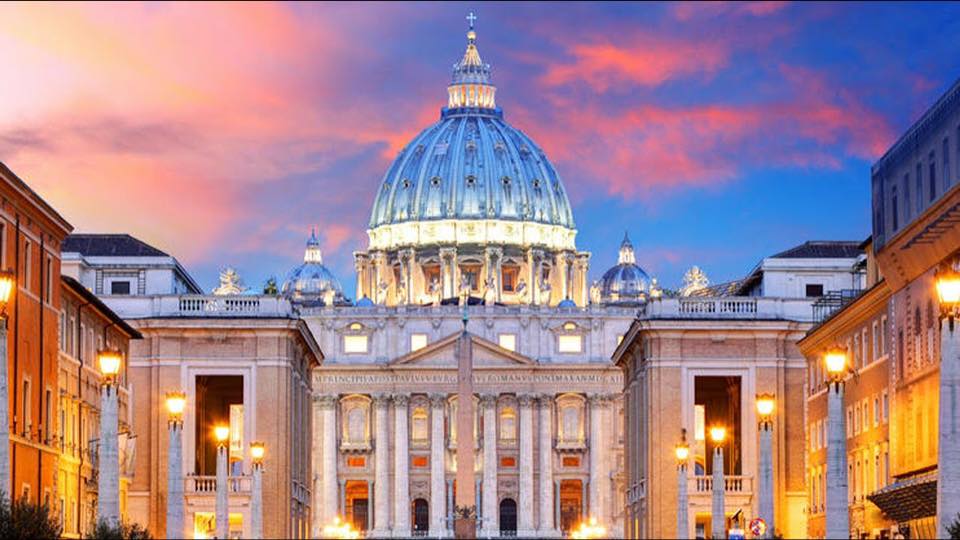Vatican Art – Catholic History – Sistine Chapel
From the smallest country in the world, Vatican City, located in Rome, Italy  resides the headquarters of the Catholic Church.
resides the headquarters of the Catholic Church.
Over 500 years ago, Michelangelo Buonarroti worked on Saint Peter’s Basilica in the Vatican for Pope Julius II. When the Pope was late paying him and his workmen, Michelangelo would write letters saying for the sake of Saint Peter we need our money. These letters remain in the Vatican Archives. To this day you may still hear people say, “for Pete’s sake!” This is where the expression originates.
To this day “money answers all things” (Ecclesiastes 10:19). “For where your treasure is, there will your heart be also” (Matthew 6:21; Luke 12:34), as Jesus taught us.

Michelangelo completed the Sistine Chapel in 1512. Its importance in the history of art and religion cannot be overstated. During my last visit to The Sistine Chapel, I noticed the ceiling had many revealing paintings of homosexual activity, in which Michelangelo (likely a disgruntled artist upset with the papacy and immorality he saw occurring therein) exposed the internal goings on of the religious “leaders” in the Vatican during his time (between 1508 and 1512).
GOD vs RELIGION ~ https://www.amazon.com/dp/1723898589
STOP LUSTING ~ https://www.amazon.com/dp/B06XW35S2L
IMAGES of JESUS ~ https://www.amazon.com/dp/B0B39PSGP6
Imágenes de Jesús ~ https://www.amazon.com/dp/B0BBJR9Q2Z
WINGS OF WORSHIP ~ https://www.amazon.com/dp/B0BTRXDY2Z
SUPERNATURAL FIRE ~ https://www.amazon.com/dp/B07K3T9KYC
WAVES OF GOD ~ https://www.amazon.com/dp/1723991627
FAITH TO CONQUER ~ https://www.amazon.com/dp/B08FHD3L2F
Girolamo Savonarola, the Italian Dominican friar from Ferrara and preacher active in Renaissance Florence (1452–1498) was a preacher, reformer, prophet, leading political and religious figure in Florence in the 1490s. Savonarola denounced clerical corruption, despotic rule and the exploitation of the poor.
www.Tinyurl.com/PaulFDavis-Books
www.DreamMakerMinistries.com
www.PropheticPowerShift.com
www.EducationPro.us
RevivingNations@yahoo,com
Vatican Art – Catholic History – Sistine Chapel
The Sistine Chapel is a chapel in the Apostolic Palace, the pope’s official residence in Vatican City. Originally known as the Cappella Magna (‘Great Chapel’), the chapel takes its name from Pope Sixtus IV, who had it built between 1473 and 1481. Since that time, the chapel has served as a place of both religious and functionary papal activity. Today, it is the site of the papal conclave, the process by which a new pope is selected. The fame of the Sistine Chapel lies mainly in the frescoes that decorate the interior, most particularly the Sistine Chapel ceiling and The Last Judgment, both by Michelangelo.
Interestingly, the last divine judgment on religious deception will be swift and fierce (read Revelation 17-18). Pray for the Holy Spirit to give you the ability to decode the Bible and discern the truths therein. Michelangelo’s revealing art on the ceiling of The Sistine Chapel provide us some clues as to the immorality and perversion occurring within the Vatican and the Catholic Church during his generation, which most assuredly God will certainly judge, along with the false doctrine and religious practices occurring therein distracting humanity from the pure, holy, glorious, marvelous and majestic crucified and risen Christ Jesus, humanity’s faithful and true Lord and Savior.
RevivingNations@yahoo,com
Vatican Art – Catholic History – Sistine Chapel